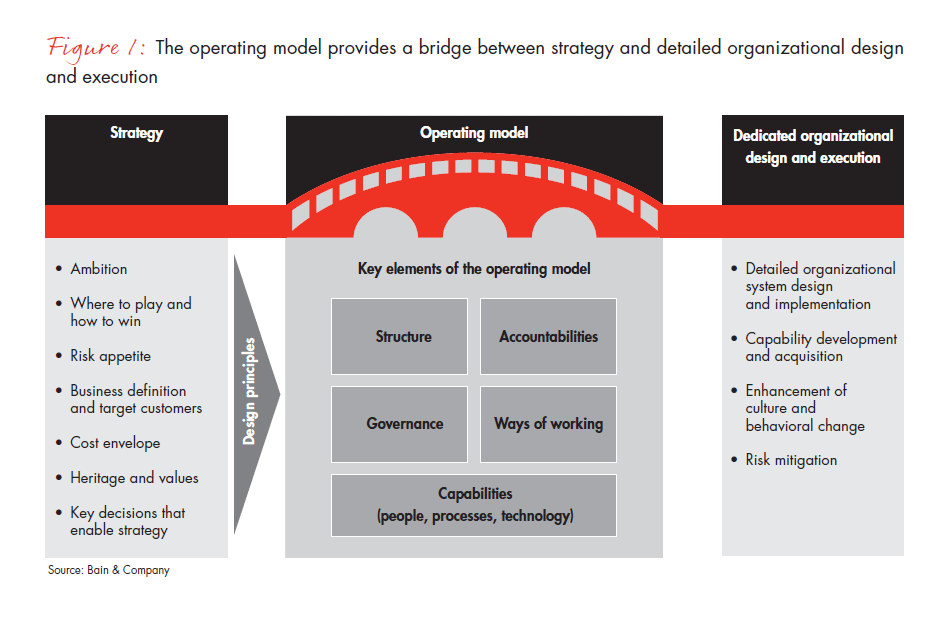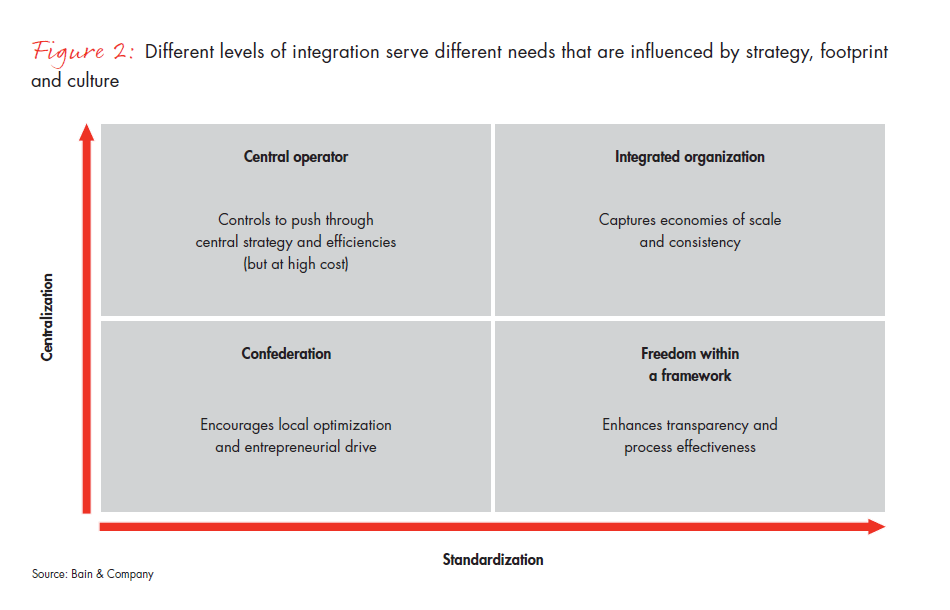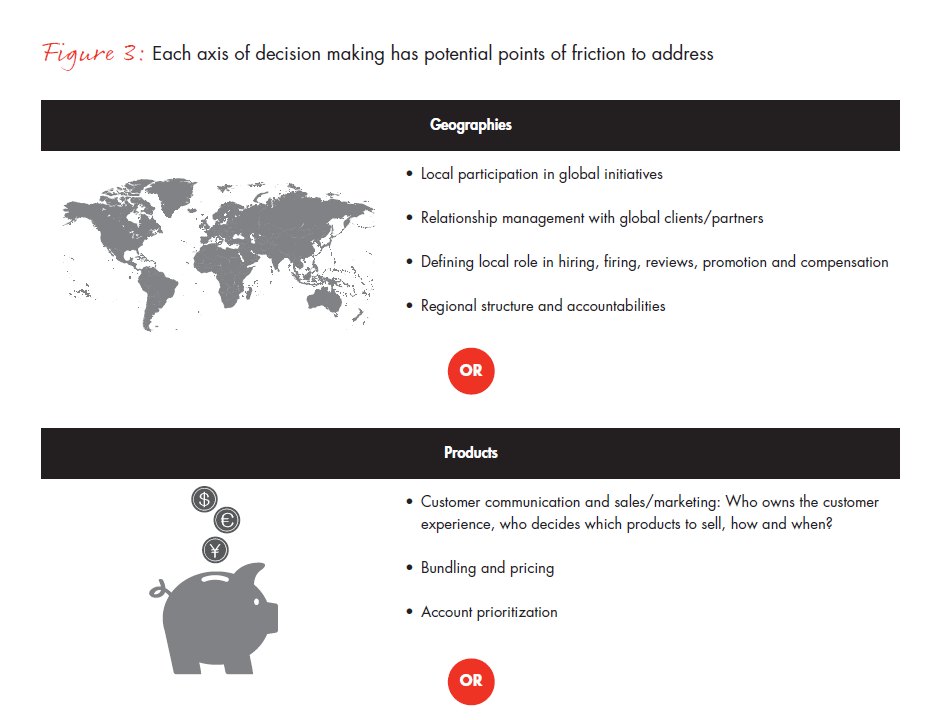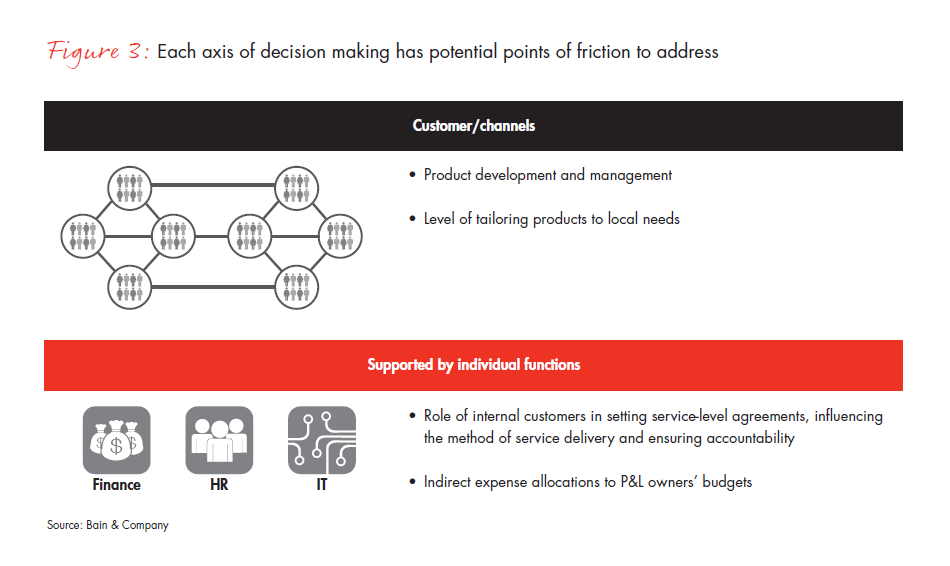Brief
A multinational property and casualty insurer with strong growth aspirations for a large emerging market assigned local executives the task of attaining that growth. However, motivated largely by short-term profit goals, global heads of products and functions at the group center routinely vetoed the local leaders’ proposals that did not meet center-imposed targets and return on capital hurdles. The head office was applying mature-market rules of thumb related to headcount growth to emerging markets, which would have needed to add employees in order to grow to scale.
With the means of growth effectively scuttled by the center, the country leadership found it difficult to grow or to attract and retain top local talent. Strategic aspirations were undercut by misalignment between the center and the regions—a classic case of a company’s operating model not fitting its strategic intent. Building the right operating model has become a hot topic in the insurance industry, and many multinational insurers, which today face a common set of challenges, are pursuing similar strategies to deal with those challenges:
- Accelerating growth in emerging markets to offset lower growth in mature markets;
- Reducing costs to deal with margin pressures and the sustained low-interest-rate environment. Despite several waves of cost reduction in the wake of serial acquisitions and new product groups, structural issues remain involving fragmented operations;
- Increasing their focus on end customers and departing from the traditional focus on products and agents. For commercial insurers, this shift requires improving global coordination to meet the needs of multinational clients and brokers;
- Strengthening risk and compliance regimes;
- Responding to pressure from investors and regulators to unlock hidden pools of value and increase total shareholder return.
Given the similarity of strategies throughout the industry, the top performers are differentiated by how effectively they execute their strategies and adapt to changing conditions. The overall trend toward more integration, for example, comes with potential trade-offs, such as the dilution of the power of local leaders to act on their knowledge of local markets. Companies that are determined to become more centralized need to figure out how to do so without impairing speed and agility.
Leading insurance companies have found that designing and building the right operating model is the surest path to effective execution. We define an operating model as the bridge between strategy and detailed organization design. An operating model serves as a blueprint that defines how resources are organized and operated to accomplish critical work. And it applies to the enterprise level or the business unit or divisional level, as well as to functions such as underwriting or claims.
Building an operating model starts by defining a clear strategy and then articulating what we call design principles: a set of simple yet specific statements of what the organization must do to execute the strategy. Principles might be “enable faster and more tailored local market innovation” or “facilitate integration of future acquisitions.” These provide the criteria for testing and adjusting the model over time, bringing objectivity to what can be a politically charged process.
Once the senior team has agreed on the design principles, the operating model takes shape through choices along five dimensions (see Figure 1):
- Structure entails drawing boundaries for lines of business, defining the horizontal mechanisms that ensure coordination and scale across lines of business and setting the resource levels that reflect the role of the center. It defines the high-level “org chart,” including the role of shared services and centers of expertise.
- Accountabilities describe the roles and responsibilities of the main organizational entities and clarify how organizational units come together to make effective cross-enterprise decisions. Accountabilities should be incorporated into the company’s incentives so that everyone focuses on the things that matter most.
- Governance refers to the configuration and cadence for discussing and resolving issues of strategy, resource allocation (including talent), performance management and other cross-enterprise matters.
- Ways of working describe how people collaborate across the seams that lie between functions or teams. Behavior that’s consistent with company values is critical to effective execution of the strategy.
- Capabilities are determined by people, processes and technology. The choice of an operating model has implications for the type of talent or technology platform a company requires. A customer-centered model, for instance, benefits from having information systems that provide employees with one view of the customer.

All five elements should be carefully designed to fit the company’s strategic goals and to work in harmony. Assessing how to execute claims processing, for instance, requires asking and answering a series of questions: How can we restructure claims handling to improve the customer’s experience? How many people do we need to handle simple claims and how many for complex claims? What standards and service-level agreements should we draft? Senior leaders need to articulate their strategy at a sufficiently detailed level to inform their choices along each of the five elements.
Whether the operating model needs minor adjustments or a major overhaul, its redesign may be one of the smartest investments that senior managers can make for long-term growth. A recent Bain & Company survey of executives at 109 companies across all major regions and industries finds that top-quartile performers in operating-model indicators average five-year revenue growth that is 15% higher and operating earnings that are 23% higher than for bottom-quartile performers.
Insurance executives looking to redesign their operating models typically face four key questions.
How integrated should we be across the enterprise?
To set the degree of integration, a company must first determine which activities are usefully shared, and how they are shared, among the different business units. Many insurance companies that were relatively decentralized “confederations” of businesses with nonstandardized processes have, in recent years, become much more integrated (see Figure 2). But that’s not the most appropriate direction for all companies, and regardless of which model a company chooses, success depends on anticipating and avoiding potential pitfalls.

Some activities—for example, IT procurement—are suited to central integration, while others are more effectively managed locally as long as the center gives clear standards. Personal life insurance is a fairly local business that varies by country, so complete integration could be detrimental. In reinsurance, however, many large multinational customers want a globally consistent approach from their insurer, so in many cases integration makes more sense.
Careful analysis of the business portfolio will show how the center could add value:
- Directing allocation of resources such as top talent, financial capital and major project investments;
- Promoting standardization and eliminating duplication to achieve scale;
- Transferring good ideas and practices across businesses and potentially enforcing adoption in a programmatic way;
- Bringing good governance and oversight disciplines to individual business units;
- Optimizing the group’s legal, tax and balance sheet structure by, for example, creating a “holding company plus branches” model.
In addition to determining which activities should be centralized, companies should consider how best to share. Integration can take a range of forms, from softer guidance on allocating and transferring resources (which might limit synergies) to a complete carve-out of activities (which might add complexity and disruption).
What should be the dominant axis of decision making?
Here again, it’s useful to start with structure in order to determine whether the company makes most decisions on the basis of location, product, channel or customer. Location is the dominant axis for most global insurers today. However, it increasingly coexists with global groups organized around products or large accounts. In such cases, there is the danger of having decentralized country power with parallel organization structures layered on top of the countries, which creates complexity (see Figure 3).


Some companies that do business in markets with similar characteristics are considering a structure based on a global product group, which yields a repeatable model that can be rolled out to new countries. Choosing the dominant axis of decision making should flow from considerations related to the sources of value creation in the business. Such a choice, in turn, is influenced by country regulation and market structure. In Brazil, for instance, independent life and pension brokers have a small presence, and distribution is dominated by banks.
Once the company has established the right structure, it can consider accountability—not just boxes and lines but also the principles behind the diagram: Which business unit is responsible for which customer segments? How should the company define its value proposition, including the level of service that is required to deliver the desired customer experience? How will the key decisions actually get made?
Insurance Australia Group (IAG) recently changed the operating model for its Australian business in a way that aligns decision making more closely with the needs of end customers. The old operating model had been structured by channel, with the direct-to-customer and intermediated channel divisions operating independently. Although IAG had been enjoying strong growth and profitability, senior management wanted to improve the alignment between the organization structure and the strategy, to become more efficient and to become more responsive to customers’ changing expectations and behaviors. IAG was also able to incorporate the businesses it had recently acquired from Wesfarmers Insurance into the new structure.
The new operating model shifts the structure from the channel to two customer divisions: one for personal and one for commercial insurance. The divisions are supported by a shared-services division that manages some elements of claims sourcing, underwriting, IT and other support services. By consolidating shared and common activities, IAG is able to standardize processes, improve efficiency, strengthen centers of excellence and enhance accountability.
The structure and the lines of accountability should be supported by clear and coherent decision processes. For example, a business unit focused on the customer experience might direct the call center to answer each call more quickly and within a set budget. Logically, however, the call center should make the decision about how it will meet that need.
In this short video, Thomas Olsen, a partner in Bain’s Financial Services practice, says that companies that find a winning formula stand to dramatically improve their performance.
How can we harness our culture and ways of working to support the model?
The softer elements of culture and ways of working can make or break decision making. At many insurers, managers feel that they are entitled to be “in the loop.” This expectation leads to a lot of large meetings and a culture that drags out decision making on such questions as whether to exit an unprofitable line of business or whether to launch a new product; that aspect of the culture thus works at cross-purposes to becoming more agile and adaptive.
Cultures tend to stick. Going with the grain of a company’s culture to build on its strengths through the identification of constructive behaviors often works best to accelerate change. Companies can deploy several proven methods, including dashboards, monetary or nonmonetary incentives, performance management systems and role modeling by senior and midlevel leaders.
For example, a major insurer wanted to move from a consensus-driven organization to one that would be participative but would have a single decision-making point. Before that could happen, the company needed to change the management culture. Executives rarely challenged each other publicly in meetings. Instead, they lobbied privately—behavior that was toxic to newly established decision rights. Changing this behavior ultimately required a new CEO to reset expectations and redesign the executive decision-making process.
How do we get there?
Every operating model has to factor in practical constraints, such as local labor rules and privacy regulations. Regardless of the specific constraints, adherence to a few principles raises the odds that the necessary operating-model changes will take hold.
Follow the value. It’s difficult and resource intensive for a company to be great at everything, and in fact, being great at everything may not be necessary. Instead, the company should optimize the capabilities and decisions that are essential to its success and be “good enough” at other capabilities.
When greater integration is the answer, the precise route to achieving that may vary. For some companies, it’s best to start with functional centralization and then move to standardize processes: It’s easier to standardize if the functions or units report to common management. Other companies might determine that it’s important to realize benefits quickly by standardizing first and then moving to centralization.
Aim for consistency but know when to tailor. A global insurer with regional divisions might have each division’s HR function structured differently. Designing from the front line back will help ensure that any activity placed at the center has a good reason for being there.
Anticipate the stress points. Relying on a program office to resolve problems as they crop up is generally too reactive for a major change effort such as an operating-model redesign. A more effective approach is to anticipate potential obstacles—such as organizational fatigue or pressure to allow subscale regions or functions to exempt themselves—and to deal with these problems from the start. Ways to mitigate the risks include the following:
- Align senior leaders so that they understand why and how the operating model will change. To convince employees that the change will be worth the upheaval, it’s critical to bring the future to life by articulating the benefits (such as freeing time to focus on activities that will delight customers) rather than costs (such as areas of removed authority).
- Co-create the operating model with line managers, whose sponsorship is essential. Engage representatives from different units, particularly those people who will serve as role models for the required behaviors that will make the new model work.
- Insist that debate on the design criteria and evaluation of operating-model options be guided by data, not custom or emotion.
- Make the journey in stages, running pilot tests, rather than trying to get to the end state in one campaign.
The right operating model depends on each insurer’s particular situation. What’s critical is to make conscious choices not only on structure but also on accountabilities, governance, ways of working and capabilities—well before tinkering with the boxes and lines. Getting the operating model right takes time, and insurers that postpone focusing on this risk falling behind in the battle for growth and shareholder return.
Andrew Schwedel, Thomas Olsen, Filippo Agnoli and Peter Stumbles are partners in Bain & Company’s Global Financial Services practice. They are based, respectively, in New York, Jakarta, Moscow and Sydney.



